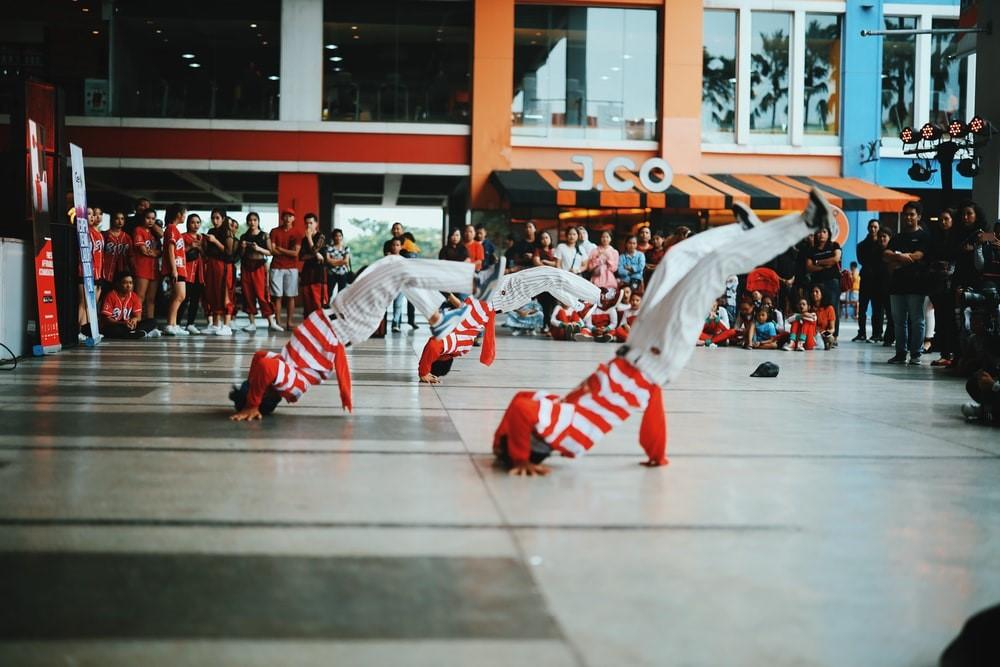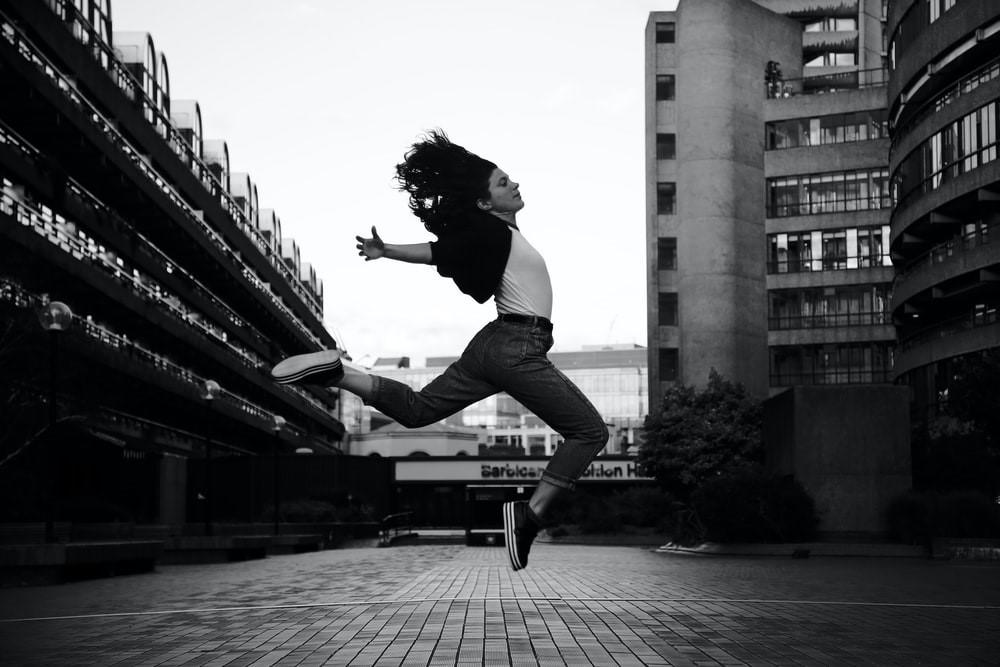Breakdance is a unique form of dance that takes the most athletic and acrobatic dance moves and fuses them with popping, locking, and other street-style dances.
Breaking typically refers to the style of dance where you use your body as a percussive instrument: popping, locking, and breaking (style specific). Though, it can also refer to many other techniques, such as house dancing or hip-hop.
When you breakdance, you not only dance on your own but hope to be part of a crew or group that will help push the art forward by improving their skill set.
So why has breakdance remained popular for so long?
Some feel it’s because break dancers can display their dance skills in front of any crowd anywhere in the world.
At its heart, breakdancing is about moving one’s body however they please while connecting all their movements to the beats of the music around them.
Where did breakdancing originate? Well, the first form of breakdancing arose in New York City during the 1970s.
During this time, many street gangs began to practice freeform dancing as an entertaining distraction and a way to promote unity among members.
Today, breakdancing culture is recognized as more than just the act of breakdancing – it has grown to represent an entire lifestyle.
The breakdance culture became popular with young African Americans growing up in America’s inner cities due to its association with hip-hop music.
People breakdance when they utilize their bodies to move in swift, rhythmic movements defined by the beats of music.
They often create sounds with their bodies or objects around them to express themselves.
This might be done in a competitive environment, known as breaking battles, but it can also be done socially at parties and other events.
Breakdancers require great strength and flexibility. They train their bodies by doing aerobic exercises like push-ups and sit-ups. The moves they perform include top rocks, down rocks, power moves, freezes, and footwork.
Today, breakdancers compete in events, such as the B-Boy Championships. Worldwide championships are held every year in a lot of countries. In 2024, it will also make its Olympic debut.
Although the culture of breakdance began as self-defense tactics, breakdancing has since grown into extremely complicated and athletic dances that can only be performed by the best of dancers.

The Evolution of Breakdancing
Breakdance culture is a global tradition that has spanned continents for years. But, exactly when did breakdancing start?
Interestingly, elements of the art of breakdancing were developed by African slaves in the United States in the early nineteenth century.
Breakdancing, also known as B-boying, is a style of street dance and part of the hip-hop culture which accompanied punk rock when it became popular in the 1970s and 1980s.
It became widespread when hip-hop music became popular in America throughout the 1960s and 1970s, and black teenagers used singing and dancing to show their dissatisfaction with racism.
Once hip-hop had ripped its way out of New York City and taken over the world in the mid-1980s and 1990s, it started spreading globally as well.
At this point, you might be wondering, “Why is it called breakdancing?”

The word ‘breakdance’ was used initially in The Village Voice newspaper in New York City to describe members of crews, such as Rock Steady Crew (RSC) and New York City Breakers (NYCB), who performed on the sidewalks in subway stations.
DJ Kool Herc, a hip-hop artist who popularized breakdance in the 1970s by adding “breaks,” or bass-heavy, and rhythmic sections from funky tunes, is often credited with popularizing the genre.
Because the breaks energized break dancers, DJ Kool Herc started bringing b-boys to his shows and speaking with them over the microphone.
During this period, Michael Jackson was one of the most celebrated celebrities in the 1980s. When he performed breakdance moves, like his famous moonwalk, the genre of breakdancing reached new heights.
Following his success, several record labels asked that R&B, pop, and rap musicians start including breakdancers in their videos.
Subsequently, celebrities like Britney Spears also started embracing breakdancing music, transforming a street dance style into a worldwide craze.
Fundamentals of Breakdancing
Elements of breakdancing work differently depending on who is doing them and what kind of dancing is happening around them. They are planned in advance to demonstrate how well someone knows breakdancing by having smooth, flawless gestures.
So, let’s explore the various elements of breakdancing!

Top Rock
Top rock steps are the ones you take while standing. Most break dancers start with full rock routines before moving on to other parts, intercutting techniques to create a visible gap between footwork, floor walk, and standing.
Down Rock
All down rock steps are done on the ground. With their feet and hands, breakers typically maintain their equilibrium. Breakdancers use their hands to support themselves while moving their feet in an introductory sequence that spins them around in a six-step motion.
Drops
The transition from down rock to top rock is known as a drop. Breakdancers can make their drops as basic or complex as they wish, tossing their bodies to the ground or including distinctive visual features or motions.
Flips
Flips are acrobatic dance moves in which a dancer leaps into the air and rotates around their vertical or horizontal axis. You should usually stick to flips that don’t require additional equipment, such as a handstand, when you’re first learning how to do this dance step.
Power Moves
Backspin, swipe, head spin, windmill, and swipe are all the basic power moves influenced by gymnastics and martial arts, emphasizing momentum and athleticism.
Find dance classes here on Superprof.

Culture of Breakdance

For those who have ever seen someone breakdance, it’s hard to deny the cultural impact this dance form has had on today’s society. What began as a street dance form in the 1970s in New York is now one of the most popular dance forms throughout the world.
Gradually, it became less about dancing for fun and more about competing.
Imagine trying to breakdance in the middle of a crowded subway station. Passerbys are bumping you as they try to exit the train, while others are jostling their way through the carts. The sound of breakbeats plays loudly over speakers, making your movements seem jerky and disjointed.
This is the breakdance culture: an environment filled with music and crowded bodies moving at breakneck speeds on their way to home or work.
The breakdance culture is a setting where anything is possible if you dare to believe and let yourself lose in movement rather than fear what others might think.
Journalist Allison Samuels claims, “breakdancing also gives kids something to do when they weren’t at school or doing their homework.”
Today, breakdancing has become an international phenomenon. You can go to any mall or city street in the world and find at least one boy gyrating to loud music spun by a DJ on his phone.
Perhaps, it was inevitable that this newest dance craze would catch on like wildfire. Nevertheless, at its heart, it is a culture rooted in tradition and history.
Benefits of Breakdance
Breakdancing is something that individuals from all walks of life are learning. In fact, once mastered, breakdancing offers several mental and physical advantages.
Stress Relief
It helps release built-up tension in the muscles and offers the mind something good to focus on, which is beneficial for stress relief. You’re not only releasing these feelings but also frustration or fury that has built up over the day.
Improves Mental Health
It can help improve your mental health since it allows you to monitor and control your stress levels by physically using your energy. Plus, it improves your discipline, attention, and commitment to reach your goals.
Enhances Fitness Levels
Breakdancing can help you reach your desired fitness levels by providing significant physical benefits, such as enhanced strength, flexibility, improved balance and coordination, weight loss, cardiovascular fitness, and muscle building in the upper body.
Dive into the electrifying world of breakdance with our exhilarating online dance classes designed to unleash your inner rhythm and creativity. Whether you're a novice eager to master the basics or an experienced dancer looking to push the boundaries of your skills, our dynamic instructors will lead you through a thrilling journey of movement, rhythm, and self-expression. Join our vibrant community of breakers and immerse yourself in the high-energy culture of this iconic dance style. From mastering power moves to perfecting your footwork, our comprehensive curriculum offers something for everyone. Don't miss your chance to be part of the excitement - enroll in our dance classes and let the beat drop as you soar to new heights in breakdance!
Career Outlook for Break Dancers
Since there are so many diverse options for break dancers, it’s impossible to say what the professional future for them looks like, with some choosing to dance alone, while others were working with a group or a company.
Of course, those who want to dance by themselves can try becoming a dance instructor or choreographer.
Whereas, if someone wants to take a more unconventional road than others, they can start their own dance company and put on shows for other companies.
Best of all, statistics suggest a massive opportunity for prospective dancers.
From 2020 to 2028, the Bureau of Labor Statistics has predicted a 29% increase in employment vacancies for dancers and choreographers.
Besides, professional breakdancers can also get sponsorships, which gives them a fee in exchange for promoting a business.
But, if you want to master the art of breakdancing, there is no better option than Superpro. They have a network of stellar breakdance tutors to guide aspiring dancers. So get in touch today!
















